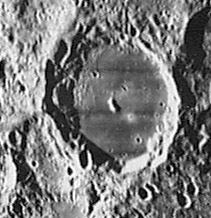Difference between revisions of "Hubble"
(Created page with "<div id="content_view" class="wiki" style="display: block"> =Hubble= (Formerly Plutarch A)<br /> {| class="wiki_table" | Lat: 22.1°N, Long: 86.9°E, Diam: 80 km, Depth...") |
|||
| Line 4: | Line 4: | ||
{| class="wiki_table" | {| class="wiki_table" | ||
| | | | ||
| − | Lat: 22.1°N, Long: 86.9°E, Diam: 80 km, Depth: 3.16 km, [http://the-moon. | + | Lat: 22.1°N, Long: 86.9°E, Diam: 80 km, Depth: 3.16 km, [http://the-moon.us/wiki/R%C3%BCkl%2027 Rükl: 27]<br /> |
|} | |} | ||
<div id="toc"> | <div id="toc"> | ||
| Line 12: | Line 12: | ||
[http://www.lpod.org/coppermine/thumbnails.php?album=search&type=full&search=Hubble LPOD Photo Gallery] [http://www.lpi.usra.edu/resources/lunar_orbiter/bin/srch_nam.shtml?Hubble%7C0 Lunar Orbiter Images] [http://www.lpi.usra.edu/resources/apollo/search/feature/?feature=Hubble Apollo Images]<br /> '''Hubble''' and its low-albedo floor are also detectable near the central part of the curved horizon in Apollo 17's oblique north-looking ''Fairchild'' camera frame [http://www.lpi.usra.edu/resources/apollo/frame/?AS17-M-0901 AS17-M-0901].<br /> Research Danny Caes<br /> <br /> | [http://www.lpod.org/coppermine/thumbnails.php?album=search&type=full&search=Hubble LPOD Photo Gallery] [http://www.lpi.usra.edu/resources/lunar_orbiter/bin/srch_nam.shtml?Hubble%7C0 Lunar Orbiter Images] [http://www.lpi.usra.edu/resources/apollo/search/feature/?feature=Hubble Apollo Images]<br /> '''Hubble''' and its low-albedo floor are also detectable near the central part of the curved horizon in Apollo 17's oblique north-looking ''Fairchild'' camera frame [http://www.lpi.usra.edu/resources/apollo/frame/?AS17-M-0901 AS17-M-0901].<br /> Research Danny Caes<br /> <br /> | ||
==Maps== | ==Maps== | ||
| − | ''([http://the-moon. | + | ''([http://the-moon.us/wiki/LAC%20zone LAC zone] 45C2)'' [http://planetarynames.wr.usgs.gov/images/Lunar/lac_45.pdf USGS Digital Atlas PDF]<br /> <br /> |
==Description== | ==Description== | ||
<br /> | <br /> | ||
| Line 18: | Line 18: | ||
[http://en.wikipedia.org/wiki/Hubble_(crater) Hubble]<br /> <br /> | [http://en.wikipedia.org/wiki/Hubble_(crater) Hubble]<br /> <br /> | ||
==Additional Information== | ==Additional Information== | ||
| − | * Depth data from [http://the-moon. | + | * Depth data from [http://the-moon.us/wiki/Kurt%20Fisher%20crater%20depths Kurt Fisher database] |
** Westfall, 2000: 3.16 km | ** Westfall, 2000: 3.16 km | ||
| − | * [http://the-moon. | + | * [http://the-moon.us/wiki/Central%20peak%20composition Central peak composition]: A & GNTA1 ([http://the-moon.us/wiki/Tompkins%20%26%20Pieters%2C%201999 Tompkins & Pieters, 1999]) |
<br /> | <br /> | ||
==Nomenclature== | ==Nomenclature== | ||
* [http://en.wikipedia.org/wiki/Edwin_Hubble Edwin Powell Hubble](November 20, 1889 – September 28, 1953) was an American astronomer. Hubble's arrival at Mount Wilson in 1919 coincided roughly with the completion of the 100-inch Hooker Telescope, then the world's largest telescope. Hubble and Milton L. Humason discovered a rough proportionality of the objects' distances with their redshifts. | * [http://en.wikipedia.org/wiki/Edwin_Hubble Edwin Powell Hubble](November 20, 1889 – September 28, 1953) was an American astronomer. Hubble's arrival at Mount Wilson in 1919 coincided roughly with the completion of the 100-inch Hooker Telescope, then the world's largest telescope. Hubble and Milton L. Humason discovered a rough proportionality of the objects' distances with their redshifts. | ||
| − | * Name given by Arthur and Whitaker in ''[http://the-moon. | + | * Name given by Arthur and Whitaker in ''[http://the-moon.us/wiki/Rectified%20Lunar%20Atlas Rectified Lunar Atlas]'' (1963) and approved by IAU in 1964 ([http://the-moon.us/wiki/Whitaker Whitaker], 1999, p.234). |
<br /> | <br /> | ||
==LPOD Articles== | ==LPOD Articles== | ||
| − | [http:// | + | [http://www2.lpod.org/wiki/January_13,_2007 Deep, Young and Ashy]<br /> <br /> |
==Bibliography== | ==Bibliography== | ||
<br /> | <br /> | ||
Revision as of 20:16, 11 April 2018
Contents
Hubble
(Formerly Plutarch A)
|
Lat: 22.1°N, Long: 86.9°E, Diam: 80 km, Depth: 3.16 km, Rükl: 27 |
Table of Contents
[#Hubble Hubble]
[#Hubble-Images Images]
[#Hubble-Maps Maps]
[#Hubble-Description Description]
[#Hubble-Description: Wikipedia Description: Wikipedia]
[#Hubble-Additional Information Additional Information]
[#Hubble-Nomenclature Nomenclature]
[#Hubble-LPOD Articles LPOD Articles]
[#Hubble-Bibliography Bibliography]
[#Hubble-Edwin P. Hubble in the Sourcebook Project (William R. Corliss) Edwin P. Hubble in the Sourcebook Project (William R. Corliss)]


left: Lunar Orbiter IV 165 h3 . right: LROC
Images
LPOD Photo Gallery Lunar Orbiter Images Apollo Images
Hubble and its low-albedo floor are also detectable near the central part of the curved horizon in Apollo 17's oblique north-looking Fairchild camera frame AS17-M-0901.
Research Danny Caes
Maps
(LAC zone 45C2) USGS Digital Atlas PDF
Description
Description: Wikipedia
Additional Information
- Depth data from Kurt Fisher database
- Westfall, 2000: 3.16 km
- Central peak composition: A & GNTA1 (Tompkins & Pieters, 1999)
Nomenclature
- Edwin Powell Hubble(November 20, 1889 – September 28, 1953) was an American astronomer. Hubble's arrival at Mount Wilson in 1919 coincided roughly with the completion of the 100-inch Hooker Telescope, then the world's largest telescope. Hubble and Milton L. Humason discovered a rough proportionality of the objects' distances with their redshifts.
- Name given by Arthur and Whitaker in Rectified Lunar Atlas (1963) and approved by IAU in 1964 (Whitaker, 1999, p.234).
LPOD Articles
Bibliography
Edwin P. Hubble in the Sourcebook Project (William R. Corliss)
- In Mysterious Universe, a handbook of astronomical anomalies (1979) :
(articles in which Hubble is mentioned)
- Page 592: New Light on Quasars: unraveling the mystery of BL Lacertae (William D. Metz, Science, 1978).
- Page 612: Was there really a Big Bang? (G.Burbidge, Nature, 1971).
- Page 623: The Geritol Universe: tired light (Science News, 1975).
- Page 624: Controversy over the Extragalactic Distance Scale (M.Rowan-Robinson, Nature, 1976).
This page has been edited 1 times. The last modification was made by - tychocrater tychocrater on Jun 13, 2009 3:24 pm - afx3u2